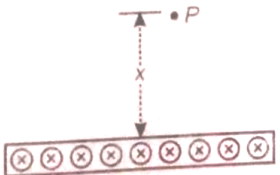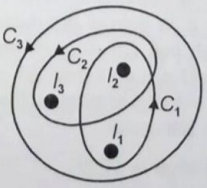A proton (mass m) accelerated by a potential difference V flies through a uniform transverse magnetic field (B). The field occupies a region of space of width 'd'. If 'a' be the angle of deviation of proton from initial direction of motion (Fig), the value of sin will be:

1.
2.
3.
4.

A rectangular loop of sides 10 cm and 5 cm carrying a current I of 12 A, is placed in different orientation as shown in figure below.
(A)
(B)
(C)
(D)
If there is a uniform magnetic field of 0.3 T in the positive Z-direction in which orientations the loop will be (i) stable equilbrium and (ii) unstable equilibrium:
1. A and D respectively
2. B and D respectively
3. B and C respectively
4. A and B respectively
A positive charge 'q' of mass 'm' is, moving along the +x axis. We wish to apply a uniform magnetic field B for time t so that the charge reverses its direction crossing the y-axis at a distance 'd'. Then
1.
2.
3.
4.
Consider the three closed loops drawn using solid line in the magnetic field (magnetic field lines are drawn using dotted line) of an infinite curent-carrying wire normal to the plane of paper as shown.
Rank the line integral of the magnetic field along each path in order of increasing magnitude :
(1) 1> 2>3
(2) 1= 3>2
(3) 1=2=3
(4) 3> 2>1
The magnetic flux density B at a distance r from a long straight rod carrying a steady current varies with r as shown in figure.
| 1. | infinite | 2. | zero |
| 3. | \( \frac{\mu_0 2 i}{4 \pi} ~\text{T} \) | 4. | \( \frac{\mu_0 i}{2 r} ~\text{T} \) |
A long straight, solid metal wire of radius 2 mm carries a current uniformly distributed over its circular cross-section. The magnetic field induction at a distance 2 mm from its axis is B. Then, the magnetic field induction at distance 1 mm from axis will be
(1) B
(2) B/2
(3) 2B
(4) B
Figure shows a cross-section of a large metal sheet carrying an electric current along its surface. The current in a strip of width dl is (Kdl) where K is a constant. Find the magnetic field at a point P at a distance x from the metal strips

1.
2.
3.
4.
Three infinitely-long conductors carrying currents lie perpendicular to the plane of the paper as shown below.

If the value of integral for the loops in the units of N/A, respectively, then
1. = 3 A into the paper
2. = 3 A out of the paper
3. = 0
4. = 1 A out of the paper
A cylindrical wire of radius R is carrying current i uniformly distributed over its cross-section. If a circular loop of radius r is taken as amperian loop, then the variation value of over this loop with radius 'r' of loop will be best represented by:
(1)
(2)
(3)
(4)
















